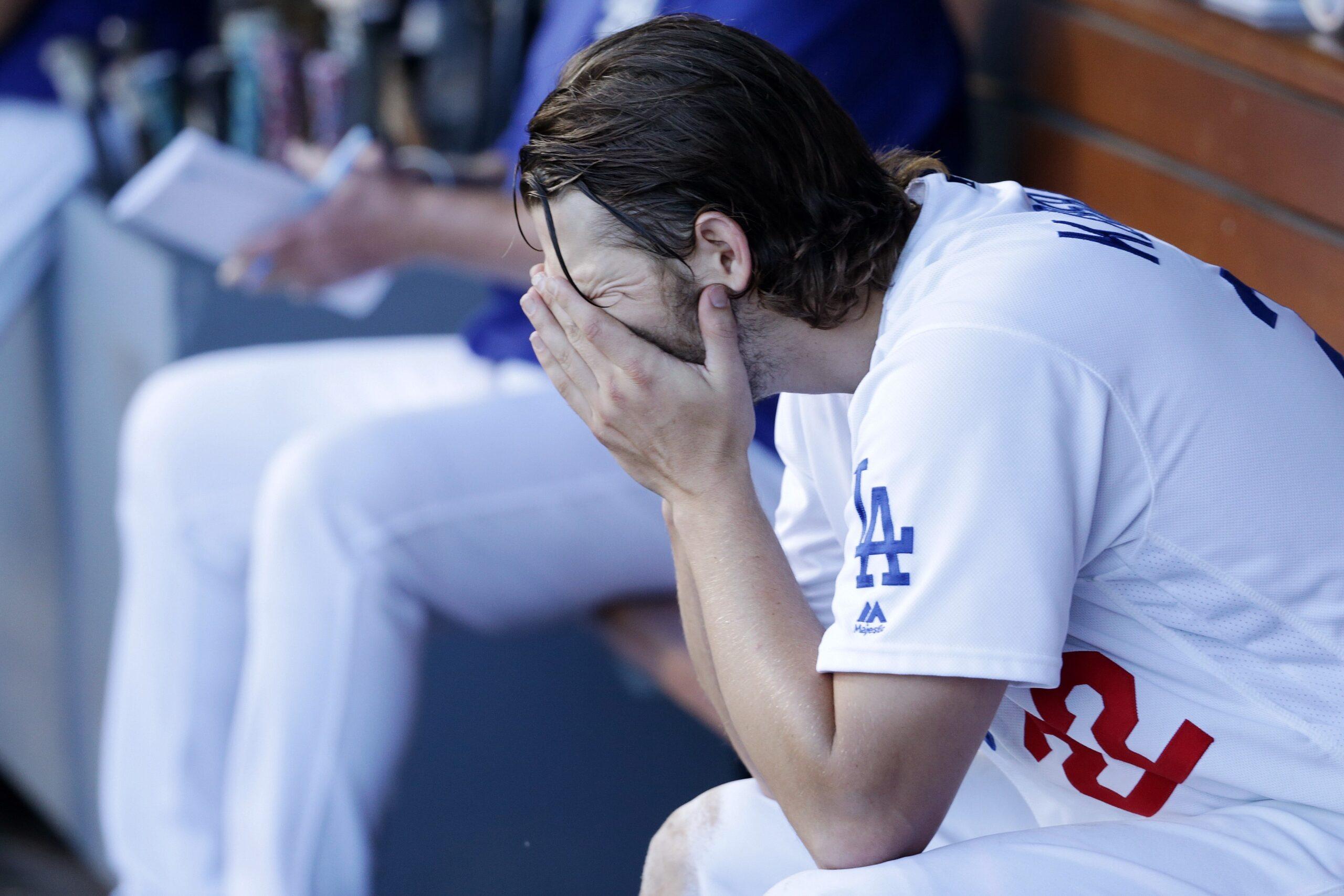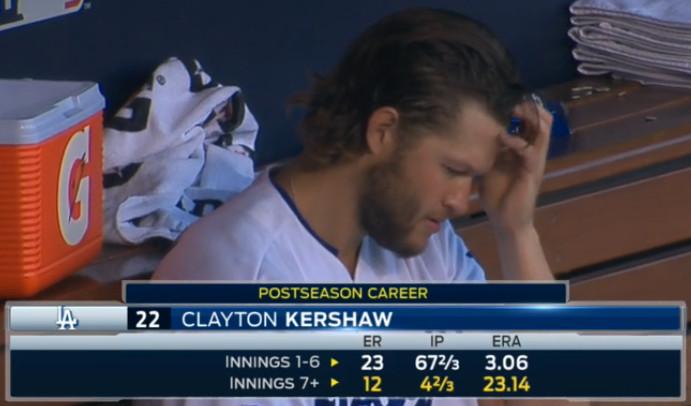
Put yourself in Clayton Kershaw’s place. (Hey, congrats on the raise!) You take the ball in a playoff elimination game, on short rest, with your recuperating back probably still at less than full strength. You’re facing one of the best teams in baseball. It’s a pretty tough assignment, and you struggle early on, taking 27 pitches to finish off a first inning in which you allow one run on a single so weak that Statcast says similar grounders go for hits only 6.7 percent of the time. Despite that inauspicious start, you feel your way through 6 2/3 innings, whiffing 11 with only two walks on 110 pitches. You set a new career high for swinging strikes in a postseason start, and you throw some of the fastest pitches you’ve delivered all year. You don’t allow any extra-base hits, but you do produce one, doubling and scoring a go-ahead run. You leave the game with a 5–2 lead.
You’re a hero, right?
Of course not: You’re Clayton Kershaw, and you can’t escape the darkest October timeline. Everything in the preceding paragraph happened, but your ERA on the day is still 6.17, and your career playoff ERA rises to 4.83. People call you a choker and complain that you didn’t do more.
The look on Kershaw’s face as he watched his bullpen blow his lead in Game 4 of the NLDS against the Nationals — well, what we could see of his face, as he hid it in his hands — could have come from a David Fincher remake of Groundhog Day.
Kershaw had walked his last batter, Bryce Harper, after throwing this pitch on 1–2 to one of baseball’s best framers:
Harper was only the third hitter Kershaw had walked all season after starting 1–2. The batter before that, Trea Turner, had singled on a grounder to Corey Seager, who would have had the force at second if he’d been quicker getting the ball out of his glove.
And because those calls went one way and not the other, Kershaw left the bases loaded instead of escaping the seventh — which, historically speaking, hasn’t been the best inning to be Kershaw once the postseason starts.

Sometimes, relievers record outs. Sometimes they even strand runners. (I swear I’ve seen this happen.) Unfortunately for Kershaw, they’ve tended not to do either of those things when it would have helped him.
One possible response goes something like this: Hey, Clayton, if you don’t like allowing runs in the seventh, stop allowing so many seventh-inning runners. But that critique undersells the greater degree of difficulty of Kershaw’s assignments. A lesser pitcher wouldn’t be asked to start so regularly on short rest; if he were, he certainly wouldn’t be stretched to the seventh without a safety net up in the pen.
Dodgers manager Dave Roberts could have hit for Kershaw (who’d thrown 89 pitches through the sixth) and asked a fresh reliever to start the seventh with a clean slate. And if Kershaw’s outing had ended in the sixth — or even one or two batters into the seventh — his success would have been celebrated, regardless of what happened while he watched from the dugout. Instead, he stayed in just long enough for his story to have a sad ending. Kershaw keeps cracking in the seventh because he keeps being pushed past the limits of the modern major leaguer, tasked with picking up a depleted pen worn out by the work of the less-effective starters who preceded him — in this case, Rich Hill and Kenta Maeda, who combined for 7 1/3 innings (on plenty of rest!) in Games 2 and 3. Kershaw is big; it’s the rest of the staff that got small.
As much blame as Kershaw’s relievers deserve for pouring fuel on every fire, Kershaw’s managers haven’t helped him in picking those pitchers. Kershaw departed with the Dodgers’ fate, and his own reputation, resting in the right and left hands, respectively, of Pedro Báez and Luis Avilán, who combined to cough up the lead without recording an out. That’s the same Pedro Báez who gave up a homer to Matt Holliday after relieving Kershaw in Game 1 of the 2014 NLDS, and a two-run single to David Wright after relieving Kershaw in Game 1 of the 2015 NLDS. Báez and Avilán were, at best, Roberts’s third- and fourth-best available bullpen arms, but they pitched the team’s two highest-leverage plate appearances. How many times do the Dodgers have to see their postseason runs suffer the same ending before they send their script out for rewrites?
In Kenley Jansen, the Dodgers have one of the four pitchers in baseball who was better than Kershaw (on a batter-by-batter basis) in 2016. He was available, we know, because he eventually pitched an overpowering ninth, which he entered without anyone on. Summoning one’s closer in the seventh is an unorthodox enough gambit that before 2016 Terry Francona existed, we could sigh when it failed to happen and say, “Well, no manager makes that move.” Now we have an example to point to, a realistic standard to which we can hold Francona’s peers. Maybe Andrew Miller’s flexibility is unique among relievers, just as Kershaw’s short-rest powers stand out among starters, but the Dodgers nearly lost because Jansen, Roberts, or some combination of both were saving a get-out-of-jam-free card for a later, lower-leverage save situation.
Kershaw was rescued from further blame by an eighth-inning rally starring the unlikely trio of Andrew Toles, Chase Utley, and pinch hitter Andre Ethier, the long-tenured Dodger who won’t go away (though not for his team’s lack of trying). The run those three pushed across gave the Dodgers a 6–5 victory, and the chance to extend their season against a rested Max Scherzer on Thursday in D.C. Hill (the apparently self-appointed starter), Julio Urias, and the rest of the relief corps will try to send L.A. to a showdown with Chicago in the NLCS and give us a happier picture of Kershaw to take with us into the winter.
It’s rare for a game to be defined by a decision made hours before first pitch, but this one was always going to be about Kershaw. Some attributed the choice to start Kershaw on short rest — despite the undeniable logic of saving him for a full-rest start in a hypothetical but equally vital Game 5 — to his stature on the team and to the difficulty of telling his teammates on Tuesday that their ace wouldn’t be with them with their backs against the wall. If any team were willing to downplay or ignore such soft factors, though, it would be Roberts’s and Andrew Friedman’s Dodgers, the team that removed Ross Stripling from a no-hitter, Rich Hill from a perfect game, and backup catcher/clubhouse Patronus A.J. Ellis from the locker next to Kershaw. The Dodgers went with Kershaw, according to Roberts, because Kershaw’s short-rest resiliency makes him an outlier, and because the Dodgers needed innings that they knew only Kershaw could provide. In that sense, playoff Kershaw is a victim of regular-season Kershaw’s success.
Others can believe what they want about the best pitcher in baseball’s Game 4 performance. But they’ll have a hard time convincing me that Kershaw wasn’t clutch.

